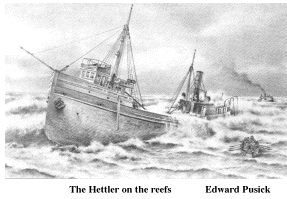


 (906) 387-4477
(906) 387-4477
The Herman H. Hettler
November 23, 1926
The HERMAN H. HETTLER was built in 1890 in West Bay City by James Davidson and Company for Campbell and Cook of Michigan City, Indiana. In design she was very much a traditional steam barge or, as this style of vessel was called on the Great Lakes, a lumber hooker. Originally named the WALTER VAIL, she was very strongly built, with heavy framing, steel arches in the sides, diagonal steel strapping and an especially robust bow for punching through ice. A 485 horsepower fore-and-aft compound steam engine provided the power. She measured 200 feet in length, 35 feet in beam, 13.3 feet in depth and 726.33 gross tons. The VAIL was valued at $80,000 and had a capacity of a million board feet of lumber. During her lifetime she had various owners. In the spring of 1913. she was sold to the Herman H. Hettler Lumber Company of Chicago, thus acquiring her final name.

On November 23, 1926, the 36 year old wooden steamer HERMAN H. HETTLER was seeking shelter in Munising Harbor from a fall gale when a reported compass variation caused her to veer off course and slam into the rock reef off Trout Point, at the north end of the east channel. The HETTLER, under Captain John M. Johnson, was en route from Ludington, Michigan to Duluth with a cargo of 1,100 tons of bulk table salt. The accident happened about 8:30 p.m. while visibility was restricted by heavy snow squalls.
The force of the grounding was so severe that it ran the steamer on the rocks up to her third hatch and forced her bow three feet out of the water! The seas were slamming into the HETTLER regularly, causing the steamer to “work” on the rocks, and slowly but steadily opening her seams. Blowing his whistle to attract attention, the captain kept his 16 man crew aboard and worked the pumps. The following day, when it was obvious the steamer wasn’t going anywhere, they launched their lifeboats, which were towed into Munising by the fishing tug PREBLE.
From town the captain notified the vessel’s owners and wired for assistance from the Great Lakes Towing Company.
After returning to the HETTLER on the 25th, the captain reported her nearly a total loss. She had pounded badly and opened many of her seams. The cargo hold was awash and the salt was rapidly dissolving! The next storm was expected to break the wreck completely. Wrecking tugs were sent for, but they were needed elsewhere to assist newer, more valuable vessels, so the aged steamer was left to fend for herself. This spelled the end for the HERMAN H. HETTLER.
The much-feared storm came on Friday the 26th. The northwester blew for 36 hours and finished off any chance for saving the HETTLER. During the storm, the stern of the steamer broke away and sank and her upper works were completely swept away. When the results of the storm were assessed, she was officially abandoned and turned over to the underwriters.

Several years after the wreck, the hull and an old schooner near the Coast Guard station were dynamited by the Coast Guard as hazards to navigation. Today the wreck is scattered over a half mile of lake bottom. On the inner edge of the reef where the HETTLER struck, her boiler can be found in about 25 feet of water, along with part of her hull and a field of debris such as mechanical parts, tanks, piping, and even a bath tub. A few hundred yards to the southwest, two sections of the steamer’s sides and the after part of her bottom lie in 10 to 20 feet of water. Deck equipment including her capstan and steam winch lie scattered and broken between the hull pieces.
The bow section of her bottom and one of her sides are 200 yards apart several hundred yards south of the rest of the wreckage in 20 to 30 feet of water. The HETTLER’s rudder and steering quadrant were salvaged years ago and are on display at the Pictured Rocks National Lakeshore headquarters at Sand Point.
In 1961 a local dive club recovered one of the HETTLER’s anchors. After spending more than 30 years as a lawn ornament in Negaunee, Michigan it was returned to the wreck site through the efforts of one of its original salvagers, local divers, and Captain Peter Lindquist of the Alger Underwater Preserve Committee and owner of Shipwreck Tours.
This report is from the book Dangerous Coast: Pictured Rocks Shipwrecks by Fred Stonehouse and Daniel Fountain, Avery Color Studios, Marquette Michigan, 1997.
